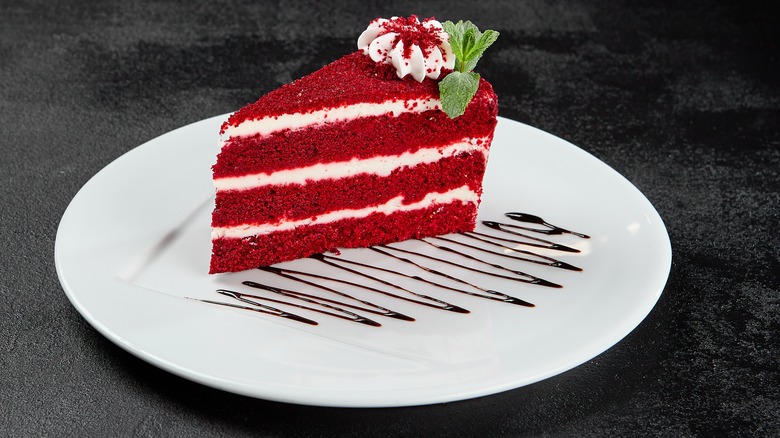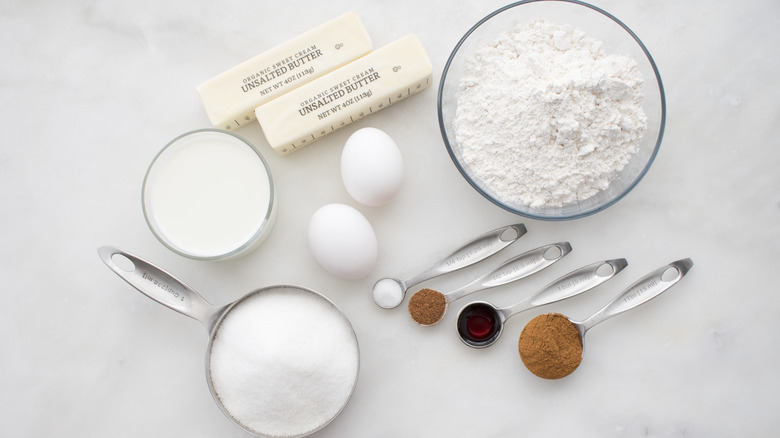Satin, Velvet, Chiffon: The Historic Reason Cakes Are Named After Fabric
Weddings are not the only occasions where cakes and dresses come together. The worlds of baking and fashion share a surprising amount of overlapping language. Probably the most famous example is the name of red velvet cake, a style that has managed to transcend the traditional realm of cake and pervade the worlds of waffles, macarons, lattes, and countless other edible items. There's even red velvet Oreos at this point — but red velvet is only the beginning. There's also blue velvet, yellow velvet, pink velvet, and white velvet.
Venturing into other fashion materials, you have chiffon cake, ermine frosting, black satin cake, French silk pie, and even tweed cake. Once you become aware of the full scope of cake-fabric crossovers, you realize it can't be a coincidence. There's a pattern at play here, and it's rooted in an old style of recipe-writing that hasn't been popular in more than a century. So, let's turn back the clock and revisit the origins of these fashionable treats.
Terms like red velvet come from the days before standardized measurements
Let's say you wanted to bake a chocolate cake for your daughter's birthday, but you didn't have much baking experience. How would you know what to do? You'd look up a chocolate cake recipe of course, and you'd use the precise measurements and baking directions it gave you. Ideally, the recipe would be accompanied by some high-definition photographs so that you could easily compare your cake to the intended results. This is the way most of us approach any type of cooking, but it wasn't always so. In years gone by, recipes didn't come with glossy photographs to judge one's work by, and oftentimes, they didn't even include measurements. It sounds crazy in retrospect, but people were baking for centuries upon centuries before words like "teaspoon" and "cup" came into fashion.
The volumetric units that most of us rely on when cooking were not standardized until the 1890s. For this, we can thank Fannie Farmer, sometimes referred to as the "Mother of Level Measurements." Although measuring cups and spoons existed long before her famous Boston Cooking-School Cookbook was published in 1896, Farmer deserves credit for popularizing standard volumetric units. Before that, many recipes called for measurements in vague terms, sometimes using comparisons like, "add butter the size of an egg." This comparative method of judgment also extended to the texture of foods, and that is how all those fabric terms ended up in cake recipes.
Fabrics served as textural comparisons
Without pictures and level measurements to guide the process, people in the past needed other ways to judge their baking. Terms like "velvet" and "chiffon" were used to describe the texture that you should be aiming for, much like the term "sponge cake". Velvet is a luxuriously soft, but densely woven fabric, while chiffon is equally soft, but far lighter. Similarly, both red velvet cakes and chiffon cakes are lusciously tender, but the chiffon is lighter with an airier crumb. Consider ermine frosting, which uses boiled milk to create a rich buttercream with the light airiness of whipped cream. It is exceptionally light and soft, much like ermine fur, which was once used to make the robes of English royalty. Lastly, you have the tweed cake, which has chocolate shavings dispersed throughout the white crumb, creating a look similar to that of tweed fabric.
Why choose fabric for these dessert names rather than some other material? The answer is, unfortunately, grounded in stereotypes about a woman's role in the household. Old cookbooks were written with women in mind, as it was assumed that they would be the ones doing all the cooking. Similarly, handling fabrics, specifically for dress-making, was also considered women's territory. For centuries (and even to this day) homemaking skills were passed through generations of women, who learned to rely on their five senses to complete any given task. A simple term like "velvet" was more than enough for experienced hands to work with.


